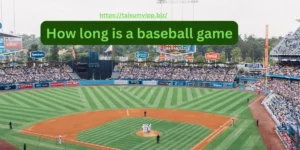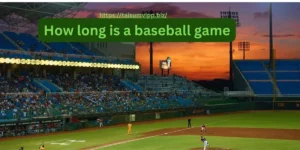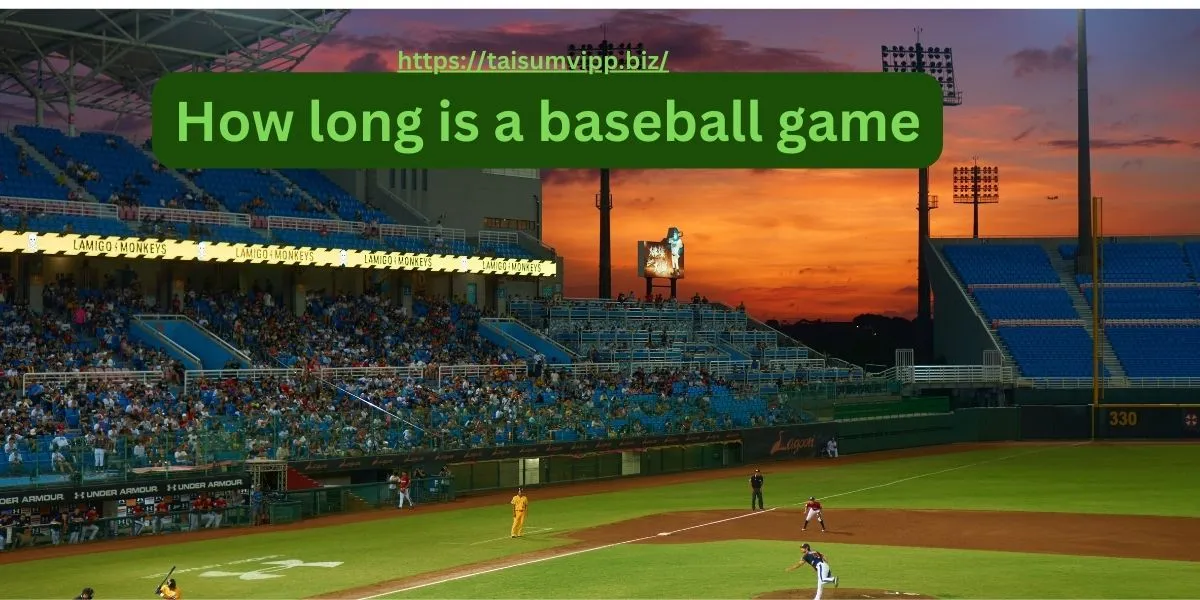Baseball is a game that has been enjoyed by fans and players alike for over a century. With its rich history and unique rules, baseball has become one of America’s favorite pastimes. One question that often comes to mind for newcomers and seasoned fans alike is: how long is a baseball game? In this article, we will dive into the various factors that affect the length of a baseball game, as well as explore some interesting aspects of the game itself.
How Long is a Baseball Game in MLB?
In Major League Baseball (MLB), the duration of a game can vary depending on several factors. On average, MLB games last around three hours. However, it is important to note that this is just an estimate, as each game is unique and can take longer or shorter to complete.
One of the main reasons why baseball games can last a relatively long time is the absence of a clock. Unlike many other sports, baseball games are not dictated by a set timeframe. Instead, they unfold inning by inning until a victor emerges. The absence of a clock creates an air of uncertainty, as teams cannot rely on time running out to secure a win.
Furthermore, the strategic nature of baseball contributes to the length of games. Managers make frequent visits to the mound to confer with pitchers, discuss defensive alignments, or make substitutions. These strategic decisions, coupled with the meticulous pace of the game, add layers of complexity that can extend the duration of play.

Another factor that can impact the length of a baseball game is extra innings. In the event of a tie at the end of the regulation nine innings, teams continue to play until a winner is determined. This can lead to games stretching well beyond the average duration, captivating fans with the suspense of sudden-death scenarios.
How Long is the Baseball Game in Innings?
A regulation baseball game consists of nine innings, with each team having the opportunity to bat and field for an equal amount of time. However, it is important to note that if the game is tied after the ninth inning, it will continue until a winner is determined. This can add extra innings to the overall game duration, which can significantly extend the playing time.
While most games are resolved within the regulated nine innings, some extraordinary games can stretch into extra innings, making the contest longer and often more thrilling for both players and fans alike.
Extra innings in baseball can create some of the most memorable moments in the sport’s history. Teams often exhaust their pitching staff, leading to strategic decisions by managers on when to substitute pitchers or position players. The tension builds with each additional inning, as every pitch and play could potentially decide the outcome of the game.
One of the longest professional baseball games on record took place in 1981 between the Pawtucket Red Sox and the Rochester Red Wings. This game lasted a staggering 33 innings, setting a new record for the longest professional baseball game in history. The marathon game captured the attention of fans across the country and highlighted the endurance and determination of the players involved.
How Long is the Baseball Classic?
The World Baseball Classic (WBC) is an international tournament held every four years, bringing together teams from around the globe. Unlike regular-season MLB games, WBC games follow a slightly different format and can be more compact in terms of duration. Each game in the WBC is limited to a maximum of 10 innings if the game is tied. If a game reaches the 10th inning and remains tied, a special rule called the “International Tiebreaker” is implemented. Under this rule, each team starts the inning with runners on first and second base, increasing the likelihood of a decisive outcome.
The implementation of the “International Tiebreaker” rule in the WBC helps to ensure that games do not extend indefinitely, providing a structure that aims to conclude the contest in a timely manner.
Furthermore, the World Baseball Classic has gained popularity over the years for its ability to showcase talent from various countries and regions. Fans have the opportunity to see players they may not typically watch in their regular baseball viewing, adding an element of excitement and diversity to the tournament.
Additionally, the WBC format allows for unexpected upsets and thrilling come-from-behind victories, creating a sense of unpredictability that keeps fans on the edge of their seats. The passion and national pride displayed by players representing their countries add an emotional depth to the games, making each matchup more than just a sporting event but a symbol of unity and competition on a global scale.
How Long is the Baseball Pitch Clock?
In recent years, there has been a growing focus on speeding up the pace of baseball games. To address this concern, a pitch clock has been introduced in some leagues, including Major League Baseball. The pitch clock is a timer that counts down the time between pitches, aiming to limit delays and keep the game moving.
The specific time allocated for each pitch can vary, but generally, the pitch clock is set to around 20 seconds. Pitchers are expected to deliver their next pitch within this timeframe, minimizing downtime and maintaining the game’s momentum. By implementing the pitch clock, games can be played at a faster pace, reducing the overall duration and increasing the entertainment value for fans.
It’s important to note that the introduction of the pitch clock has sparked debates among players, coaches, and fans. While some argue that it enhances the excitement of the game and adds a sense of urgency, others believe that it puts undue pressure on pitchers and disrupts the natural flow of the game. Despite the differing opinions, the pitch clock remains a prominent feature in modern baseball, with its impact on the sport continuing to be a topic of discussion.
Furthermore, the pitch clock is just one of many initiatives aimed at improving the pace of baseball games. Other strategies include limiting mound visits, enforcing stricter time limits between innings, and implementing instant replay reviews. These efforts reflect the ongoing evolution of baseball as it seeks to adapt to the changing preferences of audiences and maintain its position as America’s favorite pastime.
How Long is the Baseball Season?
The length of the baseball season also contributes to the overall duration of a baseball game. In MLB, the regular season typically spans from late March or early April to the end of September or early October. During this time, each team plays a total of 162 games.
With such an extensive schedule, teams compete frequently, and the cumulative effect of multiple games can impact the intensity and duration of each individual game. Additionally, postseason games, such as the playoffs and World Series, can prolong the baseball season further, extending the playing time for teams that advance.
It’s worth noting that the baseball season is not just about the games themselves. Throughout the season, teams engage in rigorous training sessions, practice drills, and strategic planning to ensure peak performance on the field. Players work tirelessly to maintain their physical fitness, hone their skills, and develop cohesive teamwork, all of which contribute to the overall spectacle of the sport.
Moreover, the baseball season is not confined to the professional level. Amateur leagues, college competitions, and youth tournaments also form an integral part of the baseball calendar, providing opportunities for aspiring players to showcase their talents and passion for the game. These grassroots events help cultivate the next generation of baseball stars and foster a deep appreciation for the sport across different age groups and communities.
How Long is the Baseball Field?
The baseball field itself is another factor to consider when pondering the duration of a baseball game. A regulation baseball field features a playing area known as the diamond, which includes bases placed 90 feet apart. The field’s dimensions, combined with the distance from the pitcher’s mound to home plate (60 feet and 6 inches), create a unique setting that requires precise throws, strategic positioning, and agile base running.
While the field’s size does not directly influence the game’s duration, it is an essential component that contributes to the overall dynamics and strategies employed by players, which can affect the length of the game indirectly.
Moreover, the outfield dimensions of a baseball field also play a crucial role in shaping the game. The outfield fence, which varies in distance depending on the ballpark, can impact the flow of the game significantly. A shorter outfield fence may result in more home runs, exciting the crowd with frequent displays of power hitting. On the other hand, a larger outfield requires outfielders to cover more ground, leading to spectacular defensive plays and strategic positioning by the fielding team.
Additionally, the type of grass or turf used on the field can influence the speed of the game. A fast outfield surface allows for quick ball movement, benefiting speedy base runners and creating a dynamic playing environment. Conversely, a slower surface can lead to more infield hits and strategic bunting tactics, altering the game’s pace and style of play.
Factors Affecting the Length of a Baseball Game
Several factors can influence the duration of a baseball game, including the performance of the pitchers, the style of play adopted by the teams, and the occurrence of breaks, such as pitching changes, timeouts, and reviews. Additionally, the significance of the game itself, such as a regular-season matchup versus a playoff game, can impact the pace and length of play.
Moreover, factors beyond the players’ control, such as weather conditions and the stadium’s infrastructure, can also play a role. Rain delays and issues with the playing surface, for example, can lead to interruptions and potential suspensions, which further extend the game’s duration.
The performance of the batters and the strategy employed by the teams can also significantly impact the length of a baseball game. A game with a high number of hits, walks, and runs scored is likely to take longer than a low-scoring affair with quick innings. Teams that focus on small ball and bunting to advance runners may have longer innings compared to teams that rely on power hitting to score quickly.
Furthermore, the umpiring crew overseeing the game can influence its length. Umpires with a tight strike zone may lead to more walks and longer at-bats, extending the overall duration of the game. Conversely, umpires who have a generous strike zone may result in quicker innings with more strikeouts, speeding up the pace of play.
How Long Does it Take for a Baseball Field to Dry?
Weather conditions, such as rain, can significantly affect the duration of a baseball game. When rain occurs, it can render the field unsafe for play, requiring the game to be paused until the field is adequately dry.
The time needed for a baseball field to dry depends on various factors, including the intensity and duration of the rain, the type of field (natural grass or artificial turf), and the effectiveness of the drainage system in place. In some cases, where heavy rain accumulates, the game may be postponed or even rescheduled to ensure fair play and the safety of the players.
Furthermore, the geographical location of the baseball field can also impact the drying time. For instance, fields in regions with high humidity levels may take longer to dry compared to fields in drier climates. The presence of direct sunlight or strong winds can expedite the drying process, allowing games to resume sooner.
Groundskeepers play a crucial role in managing the field conditions during inclement weather. They may use specialized equipment such as drying agents, turf covers, and squeegees to accelerate the drying process and ensure that the field is safe for play. Additionally, the decision to delay or cancel a game due to wet field conditions is typically made by umpires in consultation with team managers and league officials.
How to Dry a Baseball Field
To expedite the drying process and resume play as quickly as possible, grounds crews employ several techniques. One commonly used method is the application of drying agents, such as diamond dry or calcined clay, which absorb moisture from the field surface, allowing it to dry faster.
In addition to drying agents, the use of tarps and covers can protect the field during rain and prevent excessive saturation. By covering the playing area during inclement weather, grounds crews can minimize water absorption and subsequently reduce the time required for the field to dry.
Furthermore, in stadiums equipped with advanced drainage systems, water can be efficiently drained away from the field surface, aiding in the drying process. These systems help maintain the integrity of the playing surface, ensuring that games can be resumed promptly.
As we have explored throughout this article, the length of a baseball game can vary due to numerous factors. Whether it be the specific league, the number of innings played, the implementation of a pitch clock, or external elements like weather conditions, each factor plays a part in shaping the duration of a baseball game. Understanding these factors not only enhances our appreciation for the game but also allows us to appreciate the complexities that contribute to the overall experience of watching or participating in a baseball game.
Conclusion,
Baseball games, averaging three hours in Major League Baseball (MLB), lack a set timeframe, unfolding inning by inning. Strategic decisions, frequent pitching changes, and the potential for extra innings contribute to game length variability. Efforts to hasten play, like pitch clocks, seek to balance tradition with modern demands. The World Baseball Classic (WBC) limits games to 10 innings, ensuring timely conclusions. Weather delays and field maintenance can extend play, but understanding these factors enriches appreciation for baseball’s timeless allure and strategic depth.

FAQ’s:
1: How do you prepare a baseball field after rain?
Leave healing scars – Go out to the field right after a rain and, using a rake, carve the outline of each puddle. When dry, aggressively scarify your infield with a nail drag, then use the loose infield soil to fill these low areas to help the water move off the infield more effectively.
2: Can you play baseball on a wet field?
When the weather threatens to rain out a baseball game, the groundskeepers cover the infield with a tarp to protect it from damage. Generally, Major League Baseball (MLB) teams will continue to play in light to moderate rain but will suspend play if it is raining heavily or if there is standing water on the field.
3: How do you clean up a baseball field?
In some ways, baseball field maintenance is comparable to lawn maintenance. You’ll need to water and mow the grass, trim weeds, clean up debris and ensure you don’t overwater the grass to keep it in tip-top shape.
4: Is it harder to play baseball in the rain?
A wet baseball is a slippery baseball and is hard to control. Any ball hit on the ground becomes immediately soaked. Rain also greatly increases the incidence of injury. Since baseball plays an astounding 162 games, even a minor injury can cause a player to miss a lot of games.
5: How many innings are in baseball?
Nine innings
In each half, one team bats until three outs are made, with the other team playing defense. A full baseball game is typically scheduled for nine innings.
